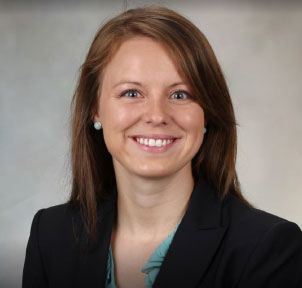 Hometown: Carrollton, KY
Hometown: Carrollton, KY
Undergrad: Western Kentucky University
Medical School: University of Louisville
Residency: Diagnostic Radiology, Mayo Clinic Arizona
- Why did you go into medicine?
Many go into medicine because of a yearning to help people navigate their health through uncertain times, and I think that's probably true for me too. I grew up in a rural area where access to medicine was limited and I saw how this affected my community and my family. Initially, I wanted to work with smoking-related diseases (lung cancer, head and neck cancer) although I was unsure where my path would lead. - What attracted you to radiology?
After spending two years in otolaryngology-head & neck surgery, I transferred into radiology after realizing my interests gravitated toward my patients' imaging and establishing a diagnosis with biopsy. Specifically, I became interested in neuroradiology and head and neck cancer. This field allows me to concentrate on the anatomy that I love, yet still see patients, perform procedures and have a direct impact on patient care. - What do you like about your everyday life in radiology?
I appreciate that on any given day, I will play a role in the care of many patients. Though this role may be small and finite, it usually occurs at some sort of decision point in the patient's care. Finding an answer (either affirmative or negative) for the patient can mean a lot so that they can move on with treatment or move on with the next phase of their life. Also, the day-to-day variety between interpreting images and performing procedures keeps the day interesting for me. - How do you feel as a woman in a male-dominated field?
Currently, nearly half of our residency is female as is our chair, which speaks volumes to the equity embraced by Mayo Clinic. While sometimes it can feel a bit isolating if you happen to be the only woman in the reading room or in a meeting, learning how to communicate effectively regardless of gender helps in most instances. There's a wealth of information, books, seminars and groups specifically geared toward female professionals that provide strategies for presenting yourself and your ideas in an effective way. What I've found most helpful is seeking out female mentors and advocates, whether at my institution or through organized radiology, and engaging in a female support community for advice and direction. It's also important to remember that there are many male radiologists committed to the cause of gender equity in the workplace. This is evidenced by the establishment of the ACR Commission for Women and Diversity, which was spearheaded by Dr. Paul Ellenbogen, and the very successful #HeForShe campaigned hosted at this year's ACR Annual Meeting. - Why do you think medical students should go into radiology?
Radiology affords the flexibility to focus on your passion — whether that's patient care, medical education or clinical research. Additionally, you can choose your practice environment such as community hospital, private practice, large academic center or hybrid practice, to name a few. Within the field, you can balance yourself as a radiologist who reads all modalities if you like variety, or subspecialize based on anatomic region to find a niche (neuroradiology, musculoskeletal, abdominal, cardiothoracic, women's imaging, etc). Depending on your practice environment, you can choose to make both diagnostic and therapeutic procedures and interventions a part of your practice. All of these factors provide for a dynamic field that allows for personal flexibility to suit individual professional aspirations.